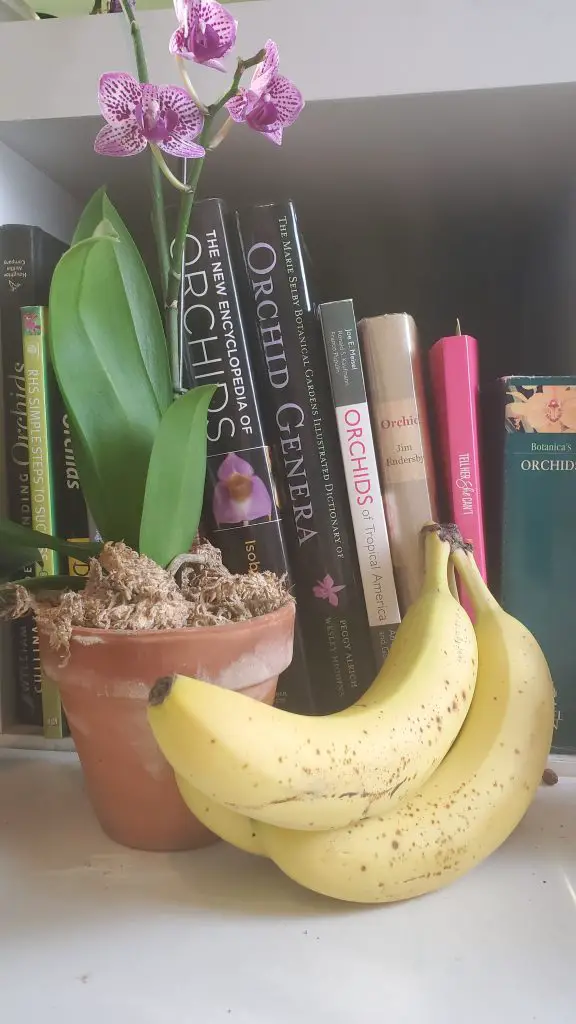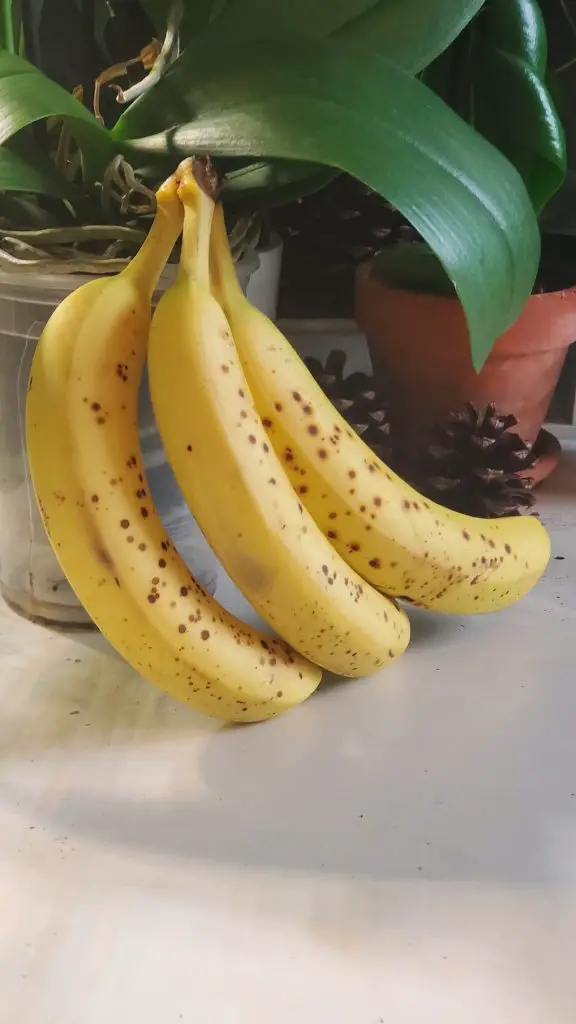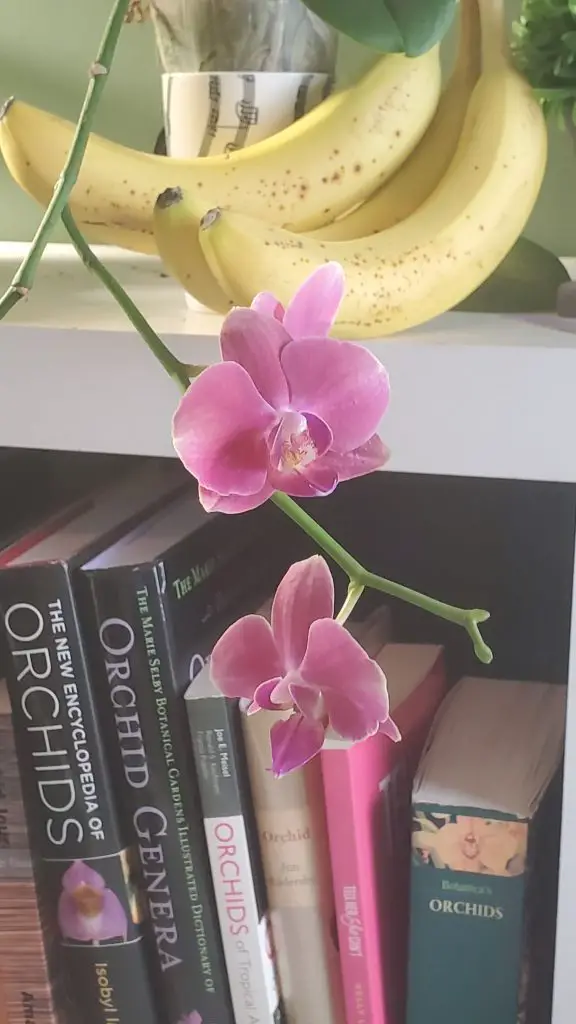Banana peels have been known to do wonders in gardens as an organic fertilizer. Their ability to enhance flower growth is phenomenal and well-known in garden centers. Banana peels have been used for a long time as a method to avoid harsh chemical treatments which produced good organic material that both houseplants and outside garden plants need.
Yet, when it comes to orchids, is fertilizing with banana peels the best way to go?
Although banana peels have a high concentration of potassium, banana peels should not be used in orchid care due to 3 things: (1) the ethylene gas that ages their development, (2) the fungus that grows in the cultured banana water, and (3) the natural attraction of ants and aphids.
Contrary to ordinary houseplants, orchids have a slower growing cycle. Ethylene gas present in banana peels stimulates an abnormal growth at a rate that is unhealthy to the orchids.
Before I go into the reasons of each one of these three, I want to say that not all methods of using banana peels are harmful to orchids. At the end of this article, I’ll show you an alternative to use banana peels that works for orchid care, producing healthy results for your orchids.
Not everything in life is in the black or white, and banana peels falls into this category of having a very “grayish” category.

Image Credit: © 2020 Orchideria.
All Rights Reserved.
NPK of Banana Peels
Banana peels are great sources of potassium, and I want to place an extreme amount of weight on the word “great”. Numerous studies have proven the efficiency of banana peels in crop plantations, like this study, published by the Scientific Research An American Publisher. (Source )
)
If you haven’t’ read my article about what NPK is, I suggest you read that first by clicking here. But to summarize that article, the NPK ratio is the amounts of nitrogen, phosphorous and potassium in the fertilizer, the three major macro-nutrients that orchids need.
An orchid will need other nutrients too, like magnesium, calcium, boron, and so many others, but these are the main ones. All fertilizer have (or should have) this ratio printed on the label.
The amount of potassium in the third number (K) in the label. While many fertilizers have a balanced NPK ratio of 20-20-20, others have a very distinct amount, like this one (Affiliate Link ). In this example, the NPK ratio is 11-35-15, so the strongest component would be the 35 (P – Phosphorous).
). In this example, the NPK ratio is 11-35-15, so the strongest component would be the 35 (P – Phosphorous).
It’s hard to find a fertilizer with a high potassium component (the third number), and banana peels are the perfect component for this.
In studies done by Frontiers in Plant Science, Crop and Product Physiology, the main symptoms of a potassium deficiency are aberrant growth, yellowing of the outer rim on older leaves due to the break down of chlorophyll, and disrupting the osmoregulation of the plant. (Source )
)

Image Credit: © 2020 Orchideria.
All Rights Reserved.
This is where the banana peel comes in handy in the fields. According to the same study mentioned above, 75% of the paddy soils in China and 67% of southern Australia soils are deficient in potassium, not reaching the 0.3mm desired level.
This outcome leads to the wide use of adding a fertilizer with high doses of potassium to the soil which transferred into home gardening worldwide.
Banana peels have an extremely high potassium level. This will vary depending on the method that you use when evaluating the banana peel. Fresh, raw banana peels have been measured containing a NPK levels of 0-3-42.
Yes, you read that right…42.
Now you see why it’s so valued in the plant world. Of course, I am still looking for a scientific studying proving those levels. Most research that I have read calls for lower percentages, yet I can’t seem to find any research stating these outrageously high numbers, as in 42.
I believe that the potassium level is high, but not that high. I’m still looking for the original source of who published that 42…
According to the study “Chemical Composition of Musa sepientum (Banana) Peels” published in the electronic Journal of Environmental, Agricultural, and Food Chemistry, the elements found in a dried banana are: concentrations (mg/g) of potassium, calcium, sodium, iron, manganese, bromine, rubidium, strontium, zirconium and niobium to be 78.10, 19.20, 24.30, 0.61, 76.20, 0.04, 0.21, 0.03, 0.02 and 0.02 respectively.
Let me highlight that: 78.10 mg/g of potassium. (Source )
)
Even though this is not a strict NPK ratio, these numbers do suggest a very high potassium level compared to the rest. So even though the garden-myth bloggers might have exaggerated a tad bit on their numbers, there is some very good evidence that potassium is indeed high.
Methods of using banana peels in orchid care
There are numerous ways to use banana peels to obtains fertilizers for orchid care. I’ll mention a few that I found, but I do want to make very clear that I have not and will not be using these on my orchids. I’ll describe each method then say why I’m against it. Of course, feel free to use whatever works for you.
1. Liquid Banana Peel Soak/ Banana Tea
In this method, you will cut up the ripe banana peels into small squares (or any shaped pieces) and add them to a water. The amounts are not necessary, just whenever you have a leftover banana peel, add it to water.
Leave this water alone for a week. After a week, the water will turn dark brown, resembling a honey-colored solution. It may have glossy-white bubbles on the top due to the fermentation of the banana peels.
Potassium is not a chemically bound element and will quickly leach into the water, making this “tea” method very high in potassium.
Strain this water, removing the old decomposed banana peels. This is the important part: do not use this water purely on the orchid. Dilute this water with more than 2/3 of normal water, then water your orchids.
Don’t use the solution straight form the bananas, since no matter how many bananas you use, it will be too strong.
Here is why I’m against it:
You know those white-glossy bubbles that formed on top your water? Well, that is due to the fermentation. This is the product of bacteria eating way at your banana peel, creating a habitat that is perfect for the proliferation of more harmful bacteria. Wherever lots of bacteria are, fungus grow. Fungus feed on bacteria, and what you have created is a mini habitat that favors fungus.
Then you add this water to your orchid?
This is not what you want lingering around in your potting media. In household plants it might work, but for orchids, that fungus is extremely hard to get rid off, because orchid love the higher humidity. Other household plants do not, and the fungus will die off in time. In an orchid pot, they won’t.
2. Apply the banana peel directly to the ORCHID vase
In this method, you can also use the same cut up banana peels and place them in the vase so they naturally decompose in the pot. This is a method used in gardening for generations and in household plants and even crop gardening, this method has its usefulness.
In fact, many articles I’ve read state that you need to add a banana peel to the bottom of each pot, then add the soil. I’ve also seen some videos (unfortunately, not very credible ones…) when a person inserts a flower stem into a banana, then places the whole banana with flower in a pot and covers it in soil.
Let me say that I am not good with household plants, just orchids. I’m not a green thumb, and my other household plants struggle. When I have friends over to my house, and they see the state of my poor plants, they question my whole “plant blogger thing”.
That’s is why I only write about orchids… So I have no idea if this is banana-burying method is good or not. If you’ve tried this, please comment below so I know.
To my objections:
I can only imagine the smell that this would create. Before I had done proper research, I bought an orchid that smelled like rotting trash. Since its pollinator is a fly, the orchid made a beautiful flower that sticks…
I say this because smells don’t really bother me that much when it comes to orchids as long as the blossom pays off… LOL. But still, I don’t want a rotting banana peel in my home office.
Ok, back to being serious… The true problem with this method is that mature banana peels will produce gas called ethylene. This gas will accelerate the growth process in most plants, making them bloom faster and have more vibrant, longer lasting blooms.
This is wonderful, right?
No. It’ really isn’t.
In other household plants, their life cycle can be accelerated and it won’t hurt the plant. Orchids, on the other hand, are slow growers. When in the presence of this gas, orchids will undergo bud blast, or even blossom blast. The accelerator is too strong for them, causing the reverse effects.
This is why the plant world articles can’t always be translated into our orchid care. If you have a proven article saying that Ethylene accelerates growth, and you have tried and tested results that are backed with evidence, that doesn’t always mean that the same results are true with orchids.
What’s worse: if this orchid is in poor health with no roots or struggling leaves, ethylene, acting as the accelerator that it is, will induce the orchid to stop focusing on proper health and induce a rapid death. The orchid cannot grow properly when forced to grow too fast.
This is a huge problem in shipping orchids. Ethylene doesn’t always come from outside sources, like gas heaters, engine exhaust, propane, and bananas, they also are produces inside the orchid itself. It’s a natural element that orchids do produce.
Just like we produce carbon dioxide liberated when we exhale, the orchid produces ethylene gas on it’s own. In small quantities that’s great, but when the orchid is boxed up in shipping, this gas becomes abundant and the orchid wilts.
Some orchid growers are shipping out little sachets of Ethylbloc ® (I’m not sponsoring anything or saying it’s effective… I’m just mentioning it) in their shipping boxed to prevent this build up. The damage done inside the box is the same that happens when banana peels are placed next to the orchid: bud blast, petal wilting, and discoloration of the blossom. (Source )
)
The other reason is ants. If you do have ants, check out this article I wrote about how to get rid of them.
3. Drying the banana peels in the sun
The third method is the safest that I’ve found while researching banana peels and orchids. In this method, you will dry the banana peels in the sun (I’ve also read that you can bake them) until they turn into a black, crispy peel. Crush this peel into a fine powder and dilute it in water.
Again, I don’t have measurements. With all types of organic fertilizers that we make at home, the measurements are not exact and it’s hard to give you an exact proportion.
This method had the lowest amount of potassium in it, and even though I’ve tried to find articles comparing raw banana peels to dried ones, most all the measurements and values are for the dried peels.
The difference in the raw, fresh peel to the leathery, sun-baked one is that the values in the baked peel are similar to any other fruit or vegetable, as tomatoes, beets, or potatoes.
Only one author said that this method was a waste of time, since dried peels, even ground up into a fine powder and added to water would not benefit the plant, since the they are not decomposed into plant available nutrients.

How orchids can react badly to banana peels
A rootless orchid needs to focus on producing new roots—healthy new roots—not just “dangly”, weak ones. When in presence of ethylene gas produce by the maturing banana peel, the orchid will accelerate this growth process. Except ethylene doesn’t stimulate root growth: it focuses on flowers and seeds. The whole reproductive cycle of the orchid will be stimulated to grow, leaving the roots to sit there suffering.
This is one reason why it is hard to convince people to let go of the banana tea for orchids. The results in blossoms are present. They are visible. The flower immediate works on developing an inflorescence, and if it is already developed, the blossoms are vibrant and colorful.
Yet, they wilt quickly. What first started off as a good thing, quickly matured the plant with everything related to it’s reproductive cycle: inflorescence, blossoms pollination, and seed production…and then kills the orchid.
All the energy that would have (should have) gone to developing strong healthy roots, or sustainable leaves has been bypassed and sent to grow new flowers. Once the flowers have wilted, you are left with an extremely weak orchid, that can’t depend on its roots to keep that kind of growth viable.
The leaves haven’t grown at a decent speed, and the orchid sits there… struggling to breathe.
But then it gets watered with another dose of high-count potassium water, and the orchid works on producing another flower spike. .

What methods are the best if using banana peel?
If you have no fertilizer near you, and you can’t get a hold of any store bought fertilizer, then I do suggest using the powder-tea (third method I mentioned). The trick here is to use this kind of fertilizer only when the orchid is nearing or already in the blossoming cycle of its life.
If you apply banana peel fertilizer to the orchid when it is focusing on leaf growth or pseudobulb growth, then you’ll hinder the natural growth of these phases in the orchid’s life. By interrupting or “re-scheduling” this cycle, the banana peel fertilizer will harm your orchid.
You may want to use the banana peel fertilizer if you notice potassium deficiency in orchids, but that is a rarity. Honestly, I haven’t come across any orchids that have yet shown signs of potassium deficiency. In this study, Potassium Nutrition Affects Phalaenopsis Growth and Flowering, published by the American Society of Horticultural Science. (Source )
)
Stated that all the Phalaenopsis plants were dead at the end of each flowering cycle when severe potassium deficiency was observed. In their words, “yellowing, irregular purple spots, and necrosis after spiking and flowering” was one of the signs of potassium deficiency. It’s actually one of the best studies I’ve read about the effects of potassium deficiency in orchids. Anyhow, banana peels would be beneficial in this case.
The study also concluded that orchids grown in sphagnum moss should less signs of potassium deficiency. Even though they didn’t say why, in this article I wrote about sphagnum moss, I detailed how sphagnum will absorb anything that it gets in contact with, much more than bark will.
That is why any small amount of fertilizer that you use in your pot, sphagnum moss will absorb that and later dissipate it. The roots will be exposed to potassium for longer periods of time, thus less deficiency will be visible.
That’s why it’s important to use a good quality sphagnum moss. If you don’t have any on hand, this is the one I use and have had good result with it. (Affiliate Link).
and have had good result with it. (Affiliate Link).
If you are using bark, then you might want to get a fertilizer that is high in potassium during the orchid’s flowering cycle. I suggest this one (Affiliate link) which is a MSU 13-5-17 NPK ratio.
(Affiliate link) which is a MSU 13-5-17 NPK ratio.
In all, I wish you the best in your orchid care, and may you find ways to use the banana peel that are more advantageous than adding them to your orchid potting media.
Happy cultivating!


What fertilizer do you use and how often.? I have some in wood chips and some in moss
I love my orchids but I can’t get them to grow flower spikes. Can you help and suggest what I could try. I have grow lights on them and they are blooming from old spikes but not growing new ones.Thank you.
I read that banana peels can be used to clean dust off of orchid leaves. I was wondering if you have trialed this before and what was the result?
Pouring boiling water on chopped banana peel will kill bacteria and fungi. Then cool and stand in refrigerator for 2 days strain and freeze liquid in ice cube tray. Add one banana ice cube each watering.